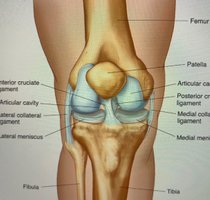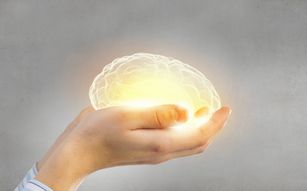Knee pain
Knee Joint
Description
The knee is a vulnerable and potentially unstable joint. The femur is balanced on the tibia with 2 "shock absorbers" of cartilage (medial and lateral menisci), 4 ligaments and the surrounding muscles to maintain stability. The ligaments are the anterior cruciate ligament (ACL), posterior cruciate ligament (PCL), medial collateral ligament (MCL) and lateral collateral ligament (LCL). In addition the patella (knee cap) slides over the anterior surface in a sesamoid joint. The joint takes the full weight of the body and considerable stress in activities such as running and jumping. It is very susceptible to problems.
Causes of Knee Pain
The knee pain can be divided into 6 different causes:
· Primary arthritis in the knee
· Reactive arthritis from other diseases
· Disease of bone around the knee
· Mechanical problems of the knee
· Direct trauma (injuries).
· Referred pain, usually from the hip
Management
Management must be holistic first as simply prescribing analgesics is rarely enough. The standard treatment of acute pain is rest, ice, compression, elevation and rehabilitation (RICER). Physiotherapists often used bracing and taping of jointsin conjunction with building VMO. Analgesia may be required, usually in the form of NSAIDs.
If the knee was swollen; Aspiration of the knee speeds recovery and reduces muscle wasting around the knee. However, fluid may reform after aspiration but it can be aspirated again. this can be associated with intra-articular steriod injection which will have long or short soothing effect.
Sportsmen in particular, should be given advice about rest and rehabilitation. They are impatient to return to activity and do not take kindly to being told simply to rest or to give up their favoured pastime. There is no reason why they should rest those parts of their body that are not affected but the injured parts require a gradual and controlled return to full activity.
Specific diseases may require specific therapies such as drugs to lower uric acid after the acute episode of gout and antibiotics to treat gonococcal infection.
Topical analgesics have no benefit over placebo.8 They may possibly give some benefit in OA for the first 2 weeks, but not thereafter.9
sprains and strains treatment:
For the first couple of days, follow the 4 steps known as RICE therapy to help bring down swelling and support the injury:
- Rest – stop any exercise or activities and try not to put any weight on the injury.
- Ice – apply an ice pack (or a bag of frozen vegetables wrapped in a tea towel) to the injury for up to 20 minutes every 2 to 3 hours.
- Compression – wrap a bandage around the injury to support it.
- Elevate – keep it raised on a pillow as much as possible.
To help prevent swelling, try to avoid heat (such as hot baths and heat packs), alcohol and massages for the first couple of days. When you can move the injured area without pain stopping you, try to keep moving it so the joint or muscle does not become stiff.
Anterior knee pain
Pain that occurs at the front and centre of the knee. It can be caused by many different problems, including: Chondromalacia of the patella -- the softening and breakdown of the tissue (cartilage) on the underside of the kneecap (patella), Runner's knee -- sometimes called patellar tendinitis, Lateral compression syndrome -- the patella tracks more to the outside part of the knee, Quadriceps tendinitis -- pain and tenderness at the quadriceps tendon attachment to the patella, Patella mal-tracking -- instability of the patella on the knee
Causes
Your kneecap (patella) sits over the front of your knee joint. As you bend or straighten your knee, the underside of the patella glides over the bones that make up the knee.
Strong tendons help attach the kneecap to the bones and muscles that surround the knee. These tendons are called: The patellar tendon (where the kneecap attaches to the shin bone). The quadriceps tendon (where the thigh muscles attach to the top of the kneecap). Anterior knee pain begins when the kneecap does not move properly and rubs against the lower part of the thigh bone. This may occur because the kneecap is in an abnormal position (also called poor alignment of the patellofemoral joint). There is tightness or weakness of the muscles on the front and back of your thigh, doing too much activity that places extra stress on the kneecap (such as running, jumping or twisting, skiing, or playing soccer).The groove in the thighbone where the kneecap normally rests is too shallow. Flat feet can be a cause.
Anterior knee pain is more common in:
People who are overweight. People who have had a dislocation, fracture, or other injury to the kneecap. Runners, jumpers, skiers, bicyclists, and soccer players who exercise often. Teenagers and healthy young adults, more often girls
Other possible causes of anterior knee pain include: Arthritis and Pinching of the inner lining of the knee during movement (called synovial impingement or plica syndrome)
Symptoms
Anterior knee pain is a dull, aching pain that is most often felt: Behind the kneecap (patella), Below the kneecap, On the sides of the kneecap, One common symptom is a grating or grinding feeling when the knee is flexed (when the ankle is brought closer to the back of the thigh), Symptoms may be more noticeable with, Deep knee bends, Going down stairs, Running downhill and Standing up after sitting for awhile
Exams and Tests
The knee may be tender and mildly swollen. Also, the kneecap may not be perfectly lined up with the thigh bone (femur). When you flex your knee, you may feel a grinding feeling below the kneecap. Pressing the kneecap when the knee is straightening out may be painful. X-ray are very often normal. However, a special x-ray view of the kneecap may show signs of arthritis or tilting.
Treatment
Resting the knee for a short period of time and taking nonsteroidal anti-inflammatory drugs (NSAIDs) such as ibuprofen, naproxen, or aspirin may help relieve pain. Other things you can do to relieve anterior knee pain include: Change the way you exercise, Learn exercises to both strengthen and stretch the quadriceps and hamstring muscles, Learn exercises to strengthen your core, Lose weight (if you are overweight), Use special shoe inserts and support devices (orthotics) if you have flat feet, Tape your knee to realign the kneecap and wear the correct running or sports shoes.
Rarely, surgery for pain behind the kneecap is needed, it includes: knee cap re-alignment, cartilage implantation, Kneecap cartilage that has been damaged may be removed, Changes may be made to the tendons to help the kneecap move more evenly., Kneecap may be realigned to allow for better joint movement, or knee cap replacement.





